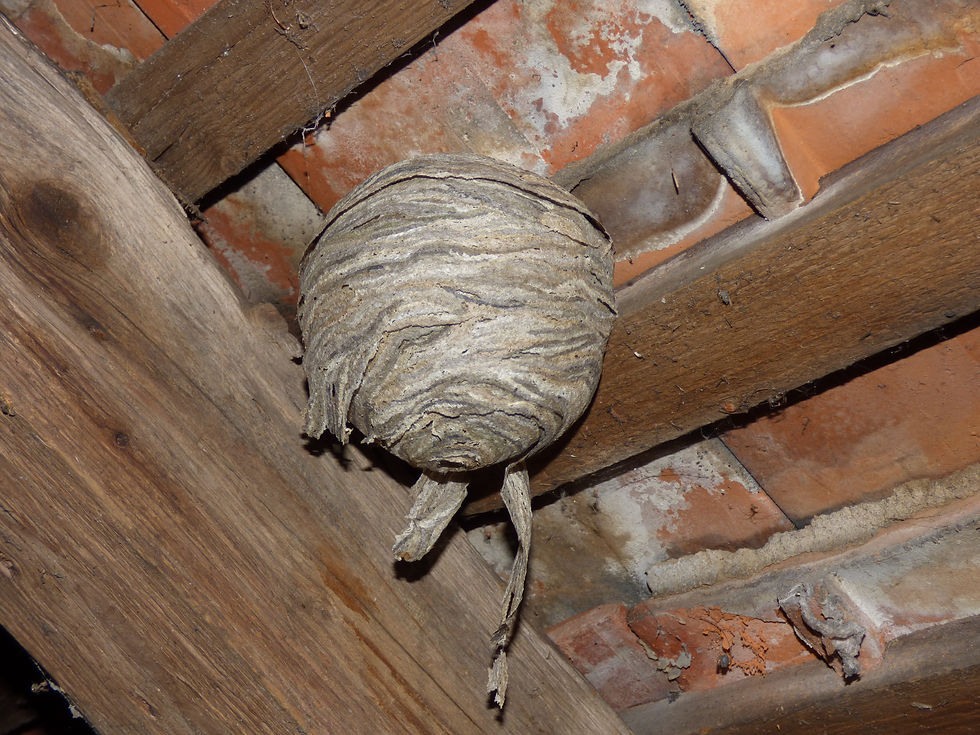Understanding the Habits and Signs of Wasps in the UK During Summer Months
- Laura Blakemore

- Jul 30
- 3 min read
Updated: Aug 6
As summer graces the UK, nature awakens, and so do its buzzing inhabitants: wasps. Often misunderstood, these insects play an important role in our ecosystem, from pollination to pest control. However, their presence can turn into a nuisance when they invade our spaces. In this post, we'll look closely at the behaviors and traits of wasps during summer, and provide essential tips for identifying and managing any wasp activity near your property.
The Life Cycle of Wasps
Wasps are social insects living in colonies that include queens, workers, and males. Their life cycle kicks off in spring when fertilized queens emerge from hibernation. Throughout the summer months, these colonies expand rapidly as queens lay thousands of eggs, sometimes up to 2,000 in a single month.
Worker wasps are crucial to the colony's survival. Their responsibilities include gathering food and constructing nests. Characterized by their slender bodies and distinctive yellow and black stripes, wasps are easy to tell apart from bees, which are rounder and fuzzier.
By late summer, wasp activity peaks, with populations soaring. Research shows that by August, a typical colony may contain as many as 5,000 wasps. This can result in more noticeable—and often inconvenient—interactions with people, particularly as their search for food intensifies.
Wasp Habits During the Summer
Wasps are opportunistic feeders, and their diet shifts dramatically with the seasons. Early in summer, they primarily feast on nectar and protein-rich insects. However, as summer advances, their craving for sugary foods increases. This makes outdoor gatherings, barbeques, and picnics prime spots for wasp sightings.
In late summer, their feeding habits enhance the likelihood of run-ins with humans. Wasps can often be spotted hovering around fruits, sweets, or leftover food, which makes dining al fresco a little less enjoyable.

Moreover, wasps are territorial creatures. They may view other insects, such as bumblebees, as competition, leading to aggressive behavior. It's important to understand that wasps typically sting only in self-defense, but their approach around food can be unsettling.
Identifying a Wasp Nest
Detecting a wasp nest is one of the clearest indicators of an infestation. Wasps prefer building their nests in hidden, sheltered areas—think attics, wall cavities, trees, or shrubs. These nests, crafted from chewed wood fibers mixed with their saliva, often have a papery look.

A spike in wasp activity around specific areas of your property is another red flag. If you see many wasps consistently gathering in one spot, a nest could be nearby. Their busiest times are usually early morning and late afternoon, so an increase in activity during these hours should not go unnoticed.
Signs of Wasp Infestation in Your Property
Identifying a wasp infestation early can help you take quick action. Here are some obvious signs to look for:
Frequent Wasps Around Food Sources: If wasps are swarming your picnic or barbeque, they may be close to a nest.
Increased Nesting Activity: A sudden uptick in wasp numbers is a strong indication that a nest has formed nearby.
Buzzing Sounds: A loud buzzing near walls or trees often signals a nest's presence. This buzzing will become increasingly noticeable as the population grows.
Visible Nests: Check under eaves, in tree branches, or within shrubs for nests. They can expand significantly through the summer, making them easier to spot.
Aggressive Behavior: If the wasps seem more territorial, especially around food, this can signal a nearby nest and potential danger.
Managing Wasps on Your Property
If you suspect a wasp infestation, consider implementing these practical steps:
Avoid Food Exposure: Keep food and trash securely covered. By eliminating easy food sources, you discourage wasps from invading your gatherings.
Seal Potential Nesting Sites: Make a habit of checking your property for cracks or holes in walls, which could allow wasps to nest. Seal these openings to prevent further incursions.
Safe Removal: While some may attempt to remove nests themselves, it is often safest to call in pest control professionals. They are trained to handle wasp removals safely.
Wasp Traps: Wasp traps can be an effective method for controlling their population. Available in most garden centers, these traps lure wasps away from your outdoor spaces.
Final Thoughts
Being aware of the habits and signs of wasps during the summer months is vital for homeowners and outdoor enthusiasts. By noting their behaviors, recognizing the signs of infestations, and acting proactively, you can enjoy the wonderful summer months without the nuisance of wasps.
Keep an eye out as you relish the sun, and remember that with the right precautions, coexisting with these seasonal insects can be manageable.




Comments